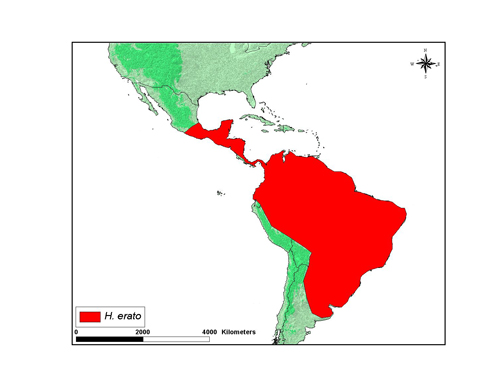Heliconius erato
Margarita Beltrán and Andrew V. Z. BrowerIntroduction
This widespread, geographically variable butterfly (see map 2 below) is involved in Müllerian mimicry with the concordantly variable Heliconius melpomene over most of its range. Only H. erato chestertonii Hewitson does not have a corresponding H. melpomene co-mimic. That race, from the upper Cauca valley of Colombia, is a co-mimic of H. cydno weymeri Staudinger.
Geographical Distribution


Distribution of Heliconius erato. © 2002 Margarita Beltran.


Distribution of Heliconius erato geographical races of Central America and the trans-Andean and the upper Amazonian regions of South America, and the closely-related H. himera (black asterisks). Symbols indicate distinct phenotypes, but some phenotypes, such as those indicated by the black and green circles, represent multiple allopatric races. Wing patterns of geographical races of H. erato are relatively uniform throughout their ranges, except where they overlap with adjacent races. In these regions, they freely hybridize, producing a hyperdiverse array of F2 and F1 backcross wing pattern phenotypes. Stippled areas of the map indicate mountainous regions uninhabited by H. erato.
Helicoinus erato races illustrated include:
- Heliconius erato petiverana Doubleday, 1847, Mexico to central Panama (black circles)
- Heliconius erato hydara Hewitson, 1867, eastern Panama to Guianas (light green circles; may represent multiple distinct races)
- Heliconius erato guarica Reakirt, 1868, Magdalena Valley, Colombia (light green circles)
- Heliconius erato demophoon Ménétriés, 1855, eastern slope of Cordillera Oriental, Colombia (black circles)
- Heliconius erato dignus Stichel, 1923, Río Putumayo, Colombia (black circles)
- Heliconius erato chestertonii Hewitson, 1872, upper Cauca Valley, Colombia (light blue stars)
- Heliconius erato venus Staudinger, 1882, Chocó, Colombia (red stars)
- Heliconius erato cyrbia Godart, 1819, western Ecuador (yellow stars)
- Heliconius erato erato (L., 1758)/H. erato amazona Staudinger, 1897/H. erato amalfreda Riffarth, 1901, Amazonia (blue squares)
- Heliconius erato notabilis Salvin & Godman, 1868, Napo, Ecuador (pink inverted triangles)
- Heliconius erato etylus Salvin, 1871, Pastaza, Ecuador (magenta Xs)
- Heliconius erato lativitta Butler, 1877, upper Amazonia (gold crosses)
- Heliconius erato emma Riffarth, 1901, northeastern Peru (orange diamonds)
- Heliconius erato venustus Salvin, 1871, Bolivia (black squares)
- Heliconius erato favorinus Hoppfer, 1874, Río Marañon, Peru (black circles)
- Heliconius erato microclea Kaye, 1907, Río Chanchamayo, Peru (purple triangles)
- Heliconius erato amphitrite Riffarth, 1901, southeastern Peru (light green circles)
- Heliconius erato phyllis Fabricius, 1775) eastern Bolivia to SE Brazil (dark green circles)
Figure modified from Mallet (1993), © 2007 Andrew V. Z. Brower.
References
Brower AVZ. 1994. Rapid morphological radiation and convergence among races of the butterfly Heliconius erato inferred from patterns of mitochondrial DNA evolution. Proc. Natl. Acad. Sci. USA 91: 6491-6495.
Brower AVZ. 1996. Parallel race formation and the evolution of mimicry in Heliconius butterflies: a phylogenetic hypothesis from mitochondrial DNA sequences. Evolution 50: 195-221.
Brown, K. S., Jr. 1979 Ecologia Geogr?fica e Evolu??o nas Florestas Neotropicais. Campinas, S?o Paulo, Brasil: Universidade Estadual de Campinas.
Descimon, H. & Mast de Maeght, J. 1983 Semispecies relationships between Heliconius erato cyrbia Godt. and H. himera Hew. in southwestern Ecuador. J. Res. Lep. 22, 229-237.
Jiggins, C. D., McMillan, W. O., King, P. & Mallet, J. 1997 The maintenance of species differences across a Heliconius hybrid zone. Heredity 79, 495-505.
Mallet, J. 1993. Speciation, raciation and color pattern evolution in Heliconius butterflies: evidence from hybrid zones. In Hybrid Zones and the Evolutionary Process (ed. R. G. Harrison), pp. 226-260. Oxford: Oxford University Press.
Sheppard, P. M., Turner, J. R. G., Brown, K. S., Benson, W. W. & Singer, M. C. 1985 Genetics and the evolution of Muellerian mimicry in Heliconius butterflies. Phil. Trans. R. Soc. Lond. B 308, 433-613.
Title Illustrations

| Scientific Name | Heliconius erato emma |
|---|---|
| Specimen Condition | Dead Specimen |
| View | Dorsal |
| Collection | Gerardo Lamas |
| Copyright | © |
| Scientific Name | Heliconius erato emma |
|---|---|
| Specimen Condition | Dead Specimen |
| View | Ventral |
| Collection | Gerardo Lamas |
| Copyright | © |
| Scientific Name | Heliconius erato favorinus |
|---|---|
| Specimen Condition | Dead Specimen |
| View | Dorsal |
| Collection | Gerardo Lamas |
| Copyright | © |
About This Page

University of Cambridge, Cambridge, UK

Middle Tennessee State University, Murfreesboro, Tennessee, USA
Correspondence regarding this page should be directed to Margarita Beltr?n at and Andrew V. Z. Brower at
Page copyright © 2006 and
- First online 18 February 2007
- Content changed 18 September 2007
Citing this page:
Beltrán, Margarita and Brower, Andrew V. Z. 2007. Heliconius erato . Version 18 September 2007 (under construction). http://tolweb.org/Heliconius_erato/72242/2007.09.18 in The Tree of Life Web Project, http://tolweb.org/






 Go to quick links
Go to quick search
Go to navigation for this section of the ToL site
Go to detailed links for the ToL site
Go to quick links
Go to quick search
Go to navigation for this section of the ToL site
Go to detailed links for the ToL site